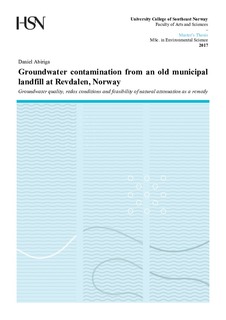| dc.description.abstract | Negative environmental impacts of landfill operations have led to establishment of stringent legislation on dumping of wastes in landfills. Emphases have been put on integration of various disciplines where experts from engineering, geology, hydrology and chemistry collaborate to ensure construction of landfills that pose less risks to the environment. Revdalen landfill has neither liners nor leachate collection system, reflecting luck of interdisciplinary collaboration in its construction, which must have been due to lack of adequate information in the year of its construction (1974). This is a report on a 23-year study of groundwater chemistry of the aquifer polluted by leachate emanating from Revdalen Landfill. The study aimed to characterise the organic and inorganic compositions of the groundwater, identify the processes governing natural attenuations, and further examine effects of landfill age, landfill closure and season on the groundwater quality.
Groundwater samples were taken twice a year from wells established using Waterloo Multilevel Groundwater Monitoring System and separate multilevel sampling wells. The samples were analysed for several chemical parameters. Results showed substantial input of mainly inorganic pollutants from the landfill. Seasonal dynamics on groundwater quality has indicated slightly higher concentrations of pollutants in dry season (autumn) than in wet season (spring). The results further demonstrated that, closing the landfill was followed by decrease in concentrations of contaminants in groundwater. Generally, concentrations of all the parameters were found to be on the verge of attaining the natural background level as the age of the landfill approached 21 years. The seasonal variations could be due to dilution in wet season and concentration effect in dry season, whereas that of landfill closure could partly be due to initiation of reducing condition that immobilised pollutants, and in part due to controlled infiltration of precipitation that would otherwise lead to wash out of pollutants. The decrease in concentrations of pollutants with age was probably a result of landfill stabilisation, when most of the contaminants would have been leached out. The redox conditions responsible for attenuation processes have been identified in the order of increasing distance from the landfill as; sulphate reducing, iron reducing, manganese reducing, nitrate reducing and finally aerobic condition. The feasibility of the aquifer acting as a treatment plant for the pollutants was very substantial, thus eliminating any serious environmental risk associated with the emanating leachate. | nb_NO |
